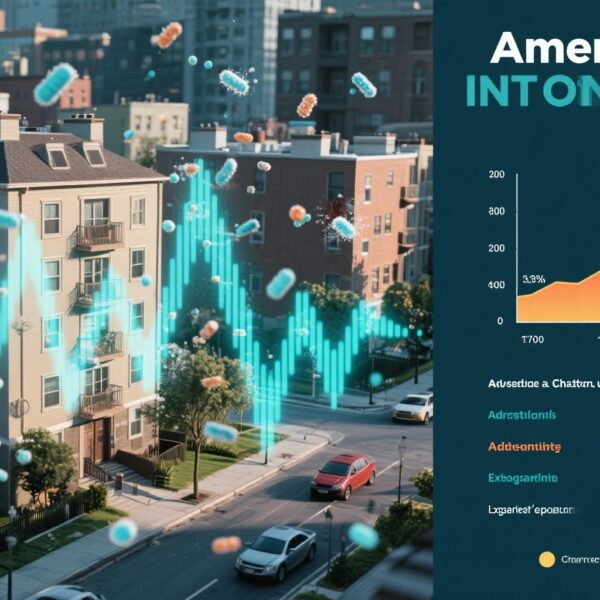Highlights
- Long-term exposure to air pollutants such as PM2.5, PM10, NO2, and NOx significantly elevates the risk of developing valvular heart disease (VHD).
- Road traffic noise, quantified by Lden and Lnight metrics, independently associates with increased VHD incidence.
- These adverse associations persist across all major VHD subtypes, irrespective of genetic predisposition.
- Understanding the mechanistic pathways linking pollution to VHD may inform preventive strategies and public health policies.
Background
Valvular heart disease (VHD) comprises a spectrum of disorders affecting heart valve structure and function, contributing substantially to cardiovascular morbidity and mortality worldwide. Traditionally linked with rheumatic fever, aging, and degenerative processes, VHD’s environmental risk factors remain incompletely characterized. Simultaneously, ambient air pollution and road traffic noise have emerged as critical public health challenges, implicated in cardiovasculardisease—primarily coronary artery disease, heart failure, and arrhythmias. However, robust evidence delineating their roles in valvular pathology has been sparse. Given the increasing global burden of VHD and the ubiquity of pollution exposure, elucidating these relationships is of paramount importance.
Key Content
Evidence from the UK Biobank Prospective Study
Song et al. (2025) conducted a landmark prospective cohort study leveraging the UK Biobank to examine air and noise pollution’s impact on incident VHD among 453,413 adults. The study employed a comprehensive air pollution score integrating PM2.5, PM2.5-10, PM10, NOx, and NO2 concentrations measured at baseline residential addresses, supplemented by road traffic noise metrics (Lden and Lnight). Participants were stratified into quintiles of exposure and followed for a median of 13.9 years during which 18,506 VHD cases were ascertained through hospitalization and mortality records.
Adjusted Cox proportional hazards models revealed a robust dose-dependent increase in VHD risk with higher pollution exposure. The highest quintile (Q5) exhibited markedly elevated hazard ratios (HRs) compared to the lowest (Q1): air pollution score (HR 1.73; 95% CI 1.61–1.87), PM2.5 (HR 1.69; 95% CI 1.57–1.82), PM2.5-10 (HR 1.43; 95% CI 1.34–1.53), PM10 (HR 1.29; 95% CI 1.22–1.36), NO2 (HR 1.59; 95% CI 1.47–1.71), NOx (HR 1.64; 95% CI 1.53–1.77). Noise exposure similarly correlated with increased risk; Lden (HR 1.66; 95% CI 1.56–1.77) and Lnight (HR 1.67; 95% CI 1.57–1.78).
Notably, these associations remained independent of genetic susceptibility to VHD, evaluated via polygenic risk scoring, underscoring pollution exposure as a modifiable environmental risk factor. Furthermore, effects were consistent across VHD subtypes, including non-rheumatic, rheumatic, and valve-specific categories (aortic, mitral, tricuspid, pulmonary).
Contextualizing with Existing Literature
Previous smaller epidemiological studies have linked air pollution with generalized cardiovascular outcomes but had limited VHD-specific data. For example, studies have associated PM2.5 exposure with increased systemic inflammation, atherosclerosis, and endothelial dysfunction, which may predispose to valve degeneration. Similarly, traffic noise is hypothesized to trigger autonomic imbalance and stress hormone release, contributing to cardiovascular remodeling.
While prior research has emphasized coronary artery disease and stroke, Song et al.’s study uniquely extends these insights to valvular heart pathology using a large-scale and well-characterized cohort, adding novel subtype analyses and consideration of genetic risk factors.
Mechanistic Insights
Biologically plausible pathways underpinning these associations involve chronic inflammatory responses to inhaled particulate matter, enhanced oxidative stress, and pro-fibrotic signaling within cardiac tissues. Pollutant-induced endothelial injury and lipid accumulation may accelerate valve leaflet degeneration and calcification processes. Noise exposure-induced sympathetic activation could exacerbate hemodynamic stress on the valves, promoting structural deterioration.
Animal studies and in vitro experiments offer preliminary support: particulate matter exposure induces inflammatory cytokine release and calcific changes in valve interstitial cells. However, mechanistic studies specifically targeting valvular changes are limited, indicating a key area for future research.
Expert Commentary
The comprehensive UK Biobank study provides compelling epidemiological evidence linking environmental pollution to increased valvular heart disease risk. Its strengths include large sample size, extended follow-up, detailed exposure assessment, and adjustment for genetic risk. However, inherent limitations of observational designs apply; residual confounding and exposure misclassification cannot be entirely excluded.
Clinical practice guidelines for VHD typically focus on surgical and medical management, with less emphasis on environmental prevention. These findings advocate for integrating environmental risk screening into cardiovascular risk assessments and reinforce public health initiatives aimed at reducing pollutant emissions and noise pollution.
Furthermore, identification of pollution exposure as a modifiable risk factor opens avenues for preventive interventions, particularly in urban and industrialized regions with high pollutant burdens. Clinicians should remain vigilant for VHD symptoms in populations residing in high-exposure areas.
Conclusion
This UK Biobank-based prospective study significantly advances understanding of environmental contributors to valvular heart disease. Long-term exposure to air and road traffic noise pollution markedly increases VHD incidence across diverse subtypes and independent of genetic predisposition.
Future directions include mechanistic investigations elucidating biological pathways, interventional studies examining benefits of pollution reduction on valve health, and incorporation of environmental risk factors in clinical risk stratification models. Public health policies targeting air and noise pollution reduction may yield substantial cardiovascular benefits extending beyond coronary and cerebrovascular disease to encompass valvular pathology.
References
- Song Y, Lin Z, Chang Z, He J, Zheng Z, Shi S, Li B, Zhu C, Fu R, Dou K. Air pollutants, road traffic noise, and incidence of valvular heart disease: A UK Biobank-based prospective study. Ecotoxicol Environ Saf. 2025 Oct 1;304:119104. doi:10.1016/j.ecoenv.2025.119104. PMID: 41005073.
- Mills NL, et al. Air pollution and cardiovascular disease: mechanisms and clinical implications. Eur Heart J. 2015;36(2):83-93. doi:10.1093/eurheartj/ehu458.
- Munzel T, et al. Environmental noise and the cardiovascular system. J Am Coll Cardiol. 2018;71(6):688-697. doi:10.1016/j.jacc.2017.12.015.
- Rajagopalan S, et al. Air pollution and cardiovascular disease: JACC State-of-the-Art Review. J Am Coll Cardiol. 2018;72(17):2054-2070. doi:10.1016/j.jacc.2018.07.099.
- Newby DE, et al. Expert position paper on air pollution and cardiovascular disease. Eur Heart J. 2015;36(2):83-93. doi:10.1093/eurheartj/ehu458.



